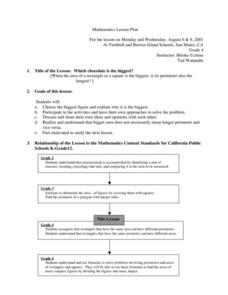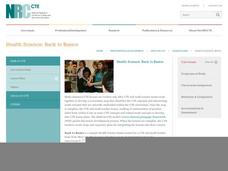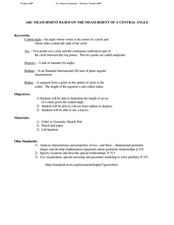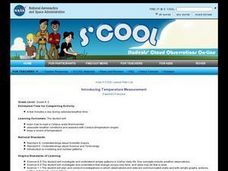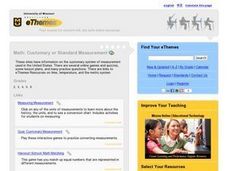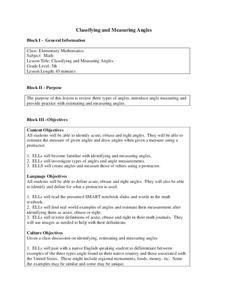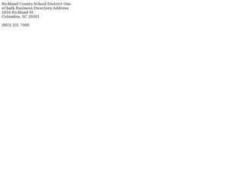Curated OER
"How Do You Measure Up?"
Fourth graders explore basic measurements by analyzing their own bodies. In this human anatomy lesson, 4th graders identify the units used to measure a human body such as centimeters, inches, ounces and pounds. Students complete a...
Curated OER
Measuring Water Temperature
Students measure the temperature of three water sources. They collect data points every second for twenty five seconds for each sample using Lego Robolab temperature sensors, complete a worksheet, and analyze the data.
Curated OER
Going Places
Second graders use non-standard units and describing, naming, interpreting, and representing relative positions in space. They investigate various areas and objects they see each day to apply ideas of navigating in space and determine...
Intel
Metric Madness
Scholars learn about the metric system and produce a presentation on how to convert within the metric system. They then develop a brochure in support of legislation requiring the use of the metric system.
Curated OER
Which Chocolate Is The Biggest?
Students investigate the concepts of area and perimeter with the use of chocolate bars. They calculate the perimeter and area of different size rectangle chocolate bars and record the statistics. Then students make a visual comparison...
National Research Center for Career and Technical Education
Health Science: Back to Basics
This lesson plan focuses on unit conversion, proportions, ratios, exponents, and the metric system. Discuss measurement with your math class and demonstrate how to solve several health-science word problems. Give learners a chance to...
Carnegie Mellon University
Battery Workshop
Introduce your class to the workings and parts of a battery-operated circuit. Pairs of pupils use lemons to make batteries and measure voltage and current with a multimeter. An accompanying worksheet is used for recording values and...
Teach Engineering
Bone Density Challenge Introduction
Can you use X-rays to measure bone mineral density? This is the essential question that learners must answer in the first installment of a seven-part series. They brainstorm ideas about necessary background information and what they...
Albert Shanker Institute
Economic Causes of the March on Washington
Money can't buy happiness, but it can put food on the table and pay the bills. The first of a five-lesson unit teaches pupils about the unemployment rate in 1963 and its relationship with the March on Washington. They learn how to create...
Curated OER
Basic Measurement for Welding
Students accurately measure pieces of metal. After reviewing basic math principles, groups of students identify proper and safe use of measuring devices. They discuss the safety procedures for other devices in the classroom. After a...
Curated OER
Algebra/Geometry Measurement
Fifth graders investigate units used to measure different geometric situations. In this geometry lesson, 5th graders measure length, mass, volume and temperature using units for measurements. They estimate the measurements before...
Curated OER
Measurement of a Central Angle
Students calculate the measurement of a central angle. In this geometry activity, students identify properties of circles. They use Cabri software to create and analyze graphs.
Curated OER
How Will You Measure Up?
Third graders use the appropriate units of measure when given a list of items to estimate and measure. They work in cooperative groups to locate, estimate, and measure given items using the correct unit of measurement.
Curated OER
Measuring the Classroom
Learners measure their classroom and determine the area. They discuss the margin of error. Each class member will write up their results separately. Students must decide what measurements to make, and attempt to measure accurately.
Curated OER
Time Zones in the United States
Eighth graders explore how to use the time zones in the United States and internationally. They use elapsed time to solve problems. Students calculate the time in various places in the United States. They discuss the 6 time zones in the...
Curated OER
Measurements in Science
Eighth graders demonstrate knowledge of metric tools by measuring common objects in the classroom. They discuss the various units of metric measurement and the scientific tools used to take them. They copy a metric ladder from a Web site.
Curated OER
Introducing Temperature Measurement
Students explore temperature and use Celcius thermometers to measure and graph the temperature in the classroom daily. They estimate what they think the temperature might be and then find the actual temperature in the room.
Curated OER
Math: Customary or Standard Measurement
Students examine resource links to examine types of measurement. They play interactive games to practice conversion. They inspect digital and analog clocks as well as the three temperature scales,
Curated OER
Significant Figures and Measurement
In this science worksheet, students draw several markings on a ruler or graduated cylinder or thermometer to get each of the correct measurements. Then they state what place the marking indicates and the number of significant figures in...
Curated OER
Classifying and Measuring Angles
Fifth graders explore the three types of angles. In this math lesson, 5th graders estimate the measure of angles and draw the angles using a protractor.
Curated OER
Measurement
Fifth graders measure specified distances when given perpendicular lines. For this measurement lesson plan, 5th graders draw the lines themselves.
Curated OER
Measure the Angle
Students measure angles. In this angle lesson, students draw angles. They use a protractor to measure angles and identify the angle as straight, right, acute, or obtuse.
Curated OER
How Many Fingers?
In this math worksheet, students use non-standard measurement to measure 5 classroom items and record the data. Students use their fingers and then ask a classmate to do the same. Students compare the data and answer 2 questions about...






